
Eucalyptus youngiana, commonly known as large-fruited mallee, Ooldea mallee and yarldarlba, is a species of mallee, less commonly a tree, that in native to arid and semi-arid areas of southern Western Australia and South Australia. It has rough, fibrous bark on some or all of the trunk, smooth bark above, lance-shaped adult leaves, flower buds in groups of three, red, pink or bright yellow flowers and short, broad, conical fruit.
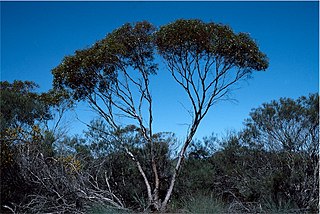
Eucalyptus horistes is a species of mallee or small tree that is endemic to Western Australia. It has smooth greyish bark, often with rough, firm fibrous bark on the base or all of the trunk, lance-shaped to elliptic adult leaves, flower buds in groups of between seven and thirteen, creamy white flowers and short cylindrical to shortened spherical fruit.

Eucalyptus porosa, commonly known as mallee box, Quorn mallee or water mallee, is a species of mallee or a tree that is endemic to southern Australia. It has rough, fibrous or flaky bark on the trunk and larger branches, smooth greyish bark above, lance-shaped adult leaves, flower buds in groups of seven, white flowers and barrel-shaped or shortened spherical fruit.

Eucalyptus banksii, commonly known as the Tenterfield woollybutt, is a tree that is endemic to eastern Australia. It has rough fibrous or flaky bark, lance-shaped to curved leaves, flower buds without a pedicel in groups of seven in leaf axils, white flowers and hemispherical to cup-shaped or conical fruit.

Eucalyptus staeri, commonly known as Albany blackbutt, is a species of small tree or a mallee and is endemic to the south-west corner of Western Australia. It has rough bark on the trunk and branches, thick, lance-shaped adult leaves, flowers buds in groups of between seven and fifteen, creamy white flowers and shortened spherical fruit.

Eucalyptus johnsoniana, commonly known as Johnson's mallee, is a species of mallee that is endemic to Western Australia. It has smooth, greyish brown bark, sometimes with flaky to fibrous brownish bark at the base, lance-shaped adult leaves, flower buds in groups of seven, creamy white flowers and shortened spherical fruit with an unusually small opening.
Eucalyptus laevis is a species of mallee or tree that is endemic to Western Australia. It has thin, rough, fibrous or flaky bark on the trunk, smooth bark above. Its adult leaves are linear to narrow lance-shaped, the flower buds are arranged in groups of between seven and eleven, the flowers are white and the fruit is cylindrical to barrel-shaped.
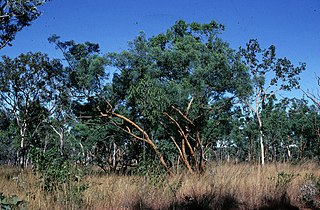
Eucalyptus lirata, commonly known as Kimberley yellowjacket, is a species of small tree or mallee that is endemic to the Kimberley region of Western Australia. It has rough, fibrous bark on the trunk and most of the branches, lance-shaped or curved adult leaves, flower buds arranged in groups of three, white flowers and cylindrical to cup-shaped fruit.

Eucalyptus mannensis, commonly known as Mann Range mallee, is a species of mallee that is native to Western Australia, South Australian and the Northern Territory. It has rough bark at the base of the trunk, smooth bark above, narrow lance-shaped adult leaves, flower buds in groups of between seven and eleven, creamy white flowers and hemispherical fruit.

Eucalyptus merrickiae, commonly known as goblet mallee, is a species of mallee that is endemic to a small area on the south coast of Western Australia. It has rough, flaky bark on part or all of the trunk, sometimes on the base of the larger branches, linear adult leaves, flower buds in groups of three, creamy white flowers and cylindrical fruit.
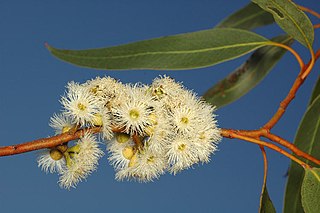
Eucalyptus petraea, commonly known as granite rock box, is a species of mallee or a small tree that is endemic to Western Australia. It has thin, ribbony or flaky to fibrous bark on the lower trunk, smooth greyish above, lance-shaped adult leaves, flower buds usually in groups of seven, creamy white flowers and conical fruit.

Eucalyptus roycei, commonly known as Shark Bay mallee, is a species of mallee or a small tree that is endemic to a small area along the Gascoyne coast of Western Australia. It has rough fibrous or flaky bark on the lower trunk, smooth greyish bark above, lance-shaped to curved adult leaves, flower buds in groups of seven or nine, cream-coloured or pale yellow flowers and cylindrical to barrel-shaped, four-sided fruit.
Eucalyptus semota, commonly known as marymia mallee, is a species of mallee or small tree that is endemic to a small area in central Western Australia. It has rough, flaky to fibrous bark on the trunk, smooth grey or brown bark above, linear to narrow lance-shaped leaves, flower buds in groups of seven or nine, white flowers and conical to cup-shaped fruit.

Eucalyptus cylindrocarpa, commonly known as the woodline mallee, is a species of mallee that is endemic to Western Australia. It has mostly smooth bark, sometimes with loose fibrous or flaky bark near the base of the trunk, linear to lance-shaped or curved adult leaves, flower buds in groups of seven, nine or eleven and cylindrical to barrel-shaped fruit.
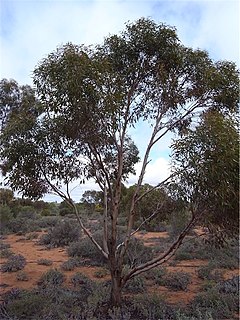
Eucalyptus dundasii, commonly known as the Dundas blackbutt, is a species of tree that is endemic to Western Australia. It has rough, scaly bark on the lower part of the trunk, smooth bark above, narrow lance-shaped to curved adult leaves, flower buds in groups of seven, creamy white flowers and cylindrical to narrow urn-shaped flowers.
Eucalyptus filiformis is a species of mallee that is endemic to a small area on the side of a mountain in Victoria, Australia. It has rough fibrous or flaky bark on the trunk, smooth bark above, narrow lance-shaped to narrow elliptical adult leaves, flower buds usually in groups of seven, white flowers and barrel-shaped fruit.
Eucalyptus pleurocorys is a species of mallee, sometimes a tree, that is endemic to Western Australia. It has rough, flaky or fibrous bark on the lower part of the trunk, smooth bark above, lance-shaped or curved adult leaves, flower buds in groups of between seven and eleven and conical fruit.
Eucalyptus provecta is a species of small tree that is endemic to Queensland. It has rough, fibrous to flaky bark on the trunk and branches, lance-shaped adult leaves, flower buds in groups of seven on the ends of branchlets, white flowers and cup-shaped fruit.
Eucalyptus infracorticata is a species of mallee that is endemic to a small area of Western Australia. It has rough, flaky or fibrous bark on the lower part of the trunk, broad lance-shaped adult leaves, flower buds in groups of between seven and eleven and short cylindrical fruit.
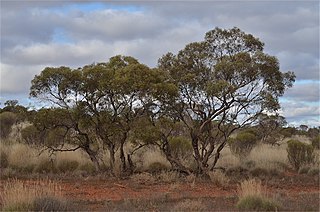
Eucalyptus socialis subsp. socialis, commonly known as the summer red mallee, is a subspecies of mallee that is endemic to inland south-eastern Australia. It usually has rough bark on the base of the trunk, smooth bark above, lance-shaped adult leaves, flower buds in groups of between seven and eleven, pale creamy white flowers and barrel-shaped to urn-shaped or spherical fruit.














